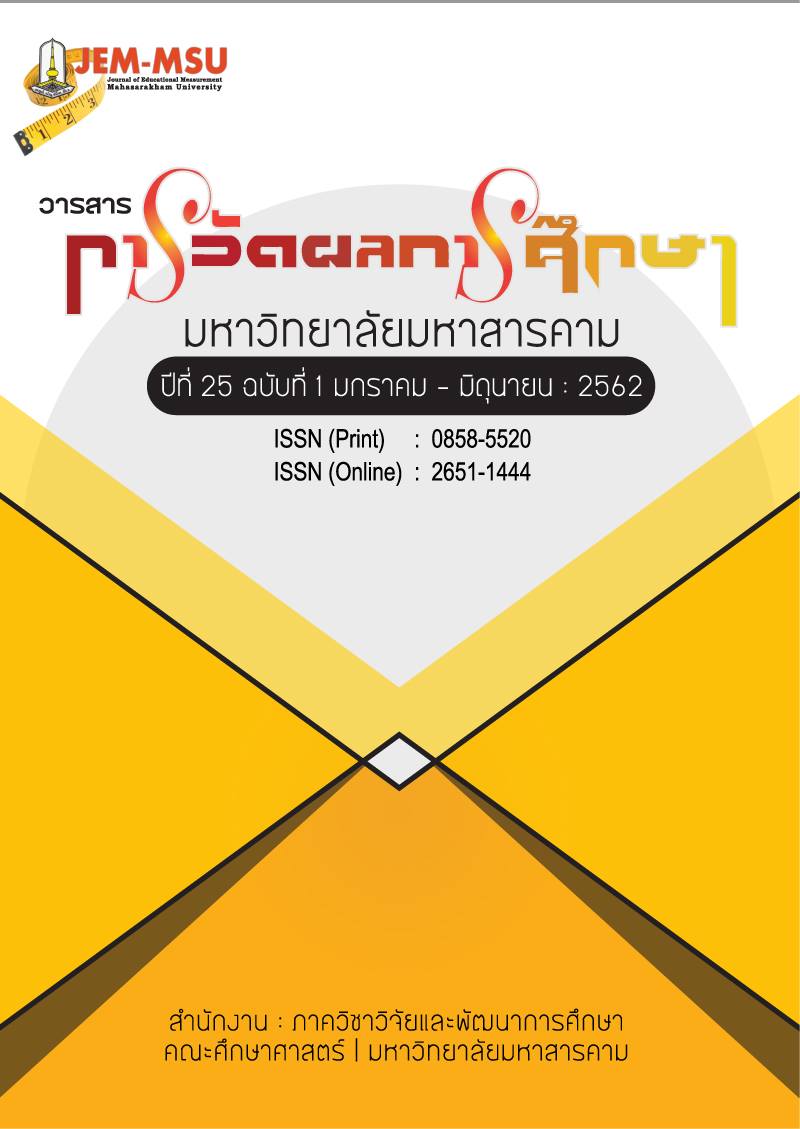A Study of the Learning Achievement and Scientific Creative Thinking of Tenth Grade Students, Using Creativity–Based Learning (CBL): Mixed–Method Research
Main Article Content
Abstract
This research aimed to: 1) compare the achievement and scientific creative thinking of 10th grade students who had learned through creativity-based learning and through regular learning; 2) study the retention of the learning achievement scores and the scientific creative thinking of the students who had learned through creativity-based learning and through regular learning; 3) study the characteristics of students with different levels of learning achievements and scientific creative thinking. The sample consisted of students studying in the first semester of the academic year 2016 in Phayakkaphumwittayakarn School, the Secondary Education Service Area Office 26, obtained through cluster random sampling. Two of 5 learning groups were randomly sampled. By drawing lots, one group became the 1st experimental group and was assigned to learn through creativity-based learning (CBL). This group consisted of 46 students from Group 6 of the tenth grade. The second experimental group was assigned to learn through regular learning (using the 5 steps of the Inquiry Cycle). This group consisted of 49 students from Group 7 of the tenth grade. The research instruments consisted of: 11 creativity-based learning activity organizing plans and 11 regular learning activity organizing plans; a learning achievement test containing 40 questions, with item discrimination (B) from 0.20 to 0.60 and the total reliability of 0.98; a scientific creative thinking test containing 4 questions with the discrimination from 0.78 to 0.86 and the total reliability of 0.90. The statistics employed in the analysis of data were percentage, the mean, standard deviation, and one–way MANOVA and Hotelling’s T2 tests were employed in the hypothesis testing.
The results are as follows.
1. The learning achievements and scientific creative thinking of the 10th grade students who had learned through creativity-based learning (CBL) and students who learned through regular learning differed, with statistical significance at the .05 level. That is, the organizing of learning activities based on the creativity-based learning (CBL) yielded higher learning achievement and scientific creative thinking than regular learning activity organizing.
2. Regarding the retention of the learning achievement scores and the scientific creative thinking of the students who had learned through creativity-based learning and through regular learning, it was found that after learning and repeated testing, the learning achievement scores and the scientific creative thinking of the students differed, with statistical significance at the .05 level. It was found that repeated testing revealed higher learning achievement scores and scientific creative thinking. That is, organizing learning using creativity-based learning and regular learning brought about the retention of the learning achievement and the scientific creative thinking.
3. Regarding the characteristics of the students with different levels of learning achievements and scientific creative thinking, it was found that the students who had low learning achievements and low scientific creative thinking came from rather permissive families. So they lacked responsibility; they were not enthusiastic in learning; and they had little interaction with teachers. On the other hand, the students who had high learning achievements and high scientific creative thinking were attentive in learning. They were willing to ask questions or talk; they read their lessons before coming to class; they searched for knowledge from the Internet; they were happy with what they did; they had imagination, and they knew how to encourage themselves and others.
Article Details
The content and information contained in the published article in the Journal of Educational Measurement Mahasarakham University represent the opinions and responsibilities of the authors directly. The editorial board of the journal is not necessarily in agreement with or responsible for any of the content.
The articles, data, content, images, etc. that have been published in the Journal of Educational Measurement Mahasarakham University are copyrighted by the journal. If any individual or organization wishes to reproduce or perform any actions involving the entirety or any part of the content, they must obtain written permission from the Journal of Educational Measurement Mahasarakham University.
References
กระทรวงศึกษาธิการ. (2551). หลักสูตรการศึกษาขั้นพื้นฐาน พุทธศักราช 2551.กรุงเทพฯ: โรงพิมพ์ชุมนุมสหกรณ์การเกษตรแห่งประเทศไทย.
ชวาล แพรัตกุล. (2536). เทคนิคการวัดผล. กรุงเทพฯ : วัฒนาพานิช.
ถนอมศรี เวชสุวรรณ์. (2558). ผลการจัดการเรียนรู้โดยวิธีการทางวิทยาศาสตร์ที่มีต่อผลสัมฤทธิ์ทางการเรียนและความคงทนในการเรียนรู้วิชาวิทยาศาสตร์ ของนักเรียนชั้นมัธยมศึกษาปีที่ 1. วิทยานิพนธ์วิทยาศาสตรมหาบัณฑิต สาขาวิทยาศาสตร์ศึกษา มหาวิทยาลัยราชภัฏนครสวรรค์.
ทิศนา แขมมณี. (2540). การคิดและการสอนเพื่อพัฒนากระบวนการคิด. กรุงเทพฯ: โครงการพัฒนาการเรียนการสอน สํานักงานคณะกรรมการการศึกษาแห่งชาติ สํานักนายกรัฐมนตรี.
ประสาท เนืองเฉลิม. (2558). แนวการเรียนรู้วิทยาศาสตร์ในศตวรรษที่ 21 (21st Century Learning in Science). วารสารพัฒนาการเรียนการสอน มหาวิทยาลัยรังสิต, 9(1), 136 -151.
ภพ เลาหไพบูลย์. (2542). แนวการสอนวิทยาศาสตร์.พิมพ์ครั้งที่ 3.กรุงเทพฯ: โรงพิมพ์ไทยวัฒนาพานิชจำกัด.
รัตนะ บัวสนธ์. (2555). วิธีการเชิงผสมผสานสำหรับการวิจัยและประเมิน. กรุงเทพฯ : จุฬาลงกรณ์มหาวิทยาลัย.
วนิช สุธารัตน์. (2547). ความคิดและความคิดสร้างสรรค์. กรุงเทพฯ : สุวีริยาสาส์น.
วิจารณ์ พานิช. (2555). วิถีการสร้างการเรียนรู้เพื่อศิษย์ในศตวรรษที่ 21. พิมพ์ครั้งที่ 1. กรุงเทพฯ : ฝ่ายโรงพิมพ์ บริษัท ตถาตา พับลิเคชั่น จำกัด.
วิริยะ ฤาชัยพาณิชย์. (2558). คู่มือการสอนเพื่อสร้างศตวรรษที่ 21. กรุงเทพฯ : ไทยวัฒนาพาณิช จำกัด
ศิริญาพร ปรีชา. (2557). การประยุกต์รูปแบบการจัดการเรียนการสอนโดยใช้ความคิดสร้างสรรค์เป็นฐานของสาขาวิชาการจัดการสารสนเทศ มหาวิทยาลัยราชภัฏนครศรีธรรมราช. คณะมนุษยศาสตร์และสังคมศาสตร์ มหาวิทยาลัยราชภัฏนครศรีธรรมราช.
สถาบันส่งเสริมการสอนวิทยาศาสตร์และเทคโนโลยี (สสวท). (2553). รูปแบบการสอนที่พัฒนากระบวนการคิดระดับสูงวิชาวิทยาศาสตร์. กรุงเทพฯ : โรงพิมพ์คุรุสภา.
______. (2559), สรุปผลการประเมิน PISA 2015 วิทยาศาสตร์ การอ่าน และคณิตศาสตร์ ความเป็นเลิศและความเท่าเทียมทางการศึกษา. กรุงเทพฯ : โรงพิมพ์คุรุสภา.
สุวิทย์ มูลคำ. (2550). กลยุทธ์การสอนคิดสร้างสรรค์. พิมพ์ครั้งที่ 4 กรุงเทพฯ : ภาพพิมพ์.
สำคัญ บุญเกิด. (2557). การศึกษาผลสัมฤทธิ์ทางการเรียน ความคงทนในการเรียนรู้ หน่วยการเรียนรู้เรื่องเสียง และจิตวิทยาศาสตร์ของนักเรียนชั้นมัธยมศึกษาปีที่ 5 ที่ได้รับการจัดการเรียนรู้แบบวัฏจักรการสืบเสาะหาความรู้. วิทยานิพนธ์ครุศาสตรมหาบัณฑิต สาขาวิชาหลักสูตรและการสอน มหาวิทยาลัยราชภัฏนครราชสีมา.
อารี พันธ์มณี. (2557). ฝึกให้คิดเป็นคิดให้สร้างสรรค์. กรุงเทพฯ: ใยไหม เอดดูเคท.
Bloom, Benjamin S. (1976). Human Characteristics and School Learning. New York: McGraw- Hill.p. 219 – 224.
Cronbach, L. J. (1951). Coefficient alpha and the internal structure of tests. psychometrika, 16(3), 297-334
Guilford, J.P. (1967). The Nature of Human Intelligence. New York: McGraw-Hill Book Co.


